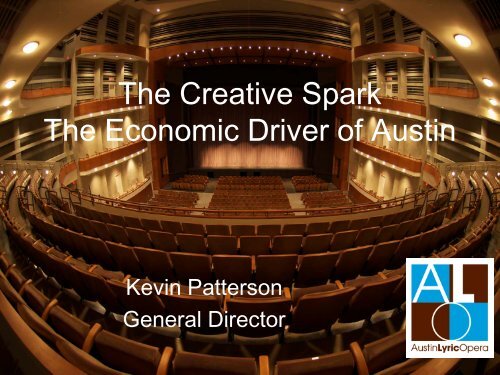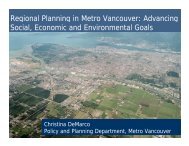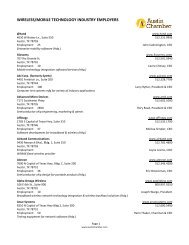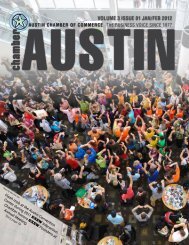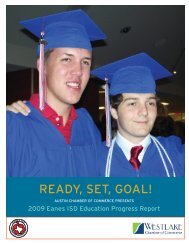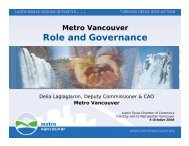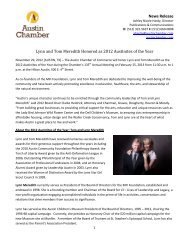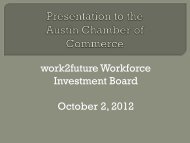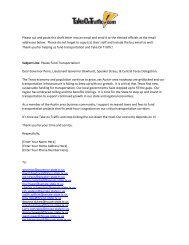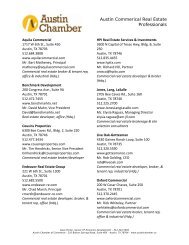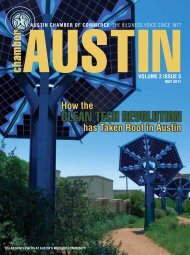The Creative Spark - The Greater Austin Chamber of Commerce
The Creative Spark - The Greater Austin Chamber of Commerce
The Creative Spark - The Greater Austin Chamber of Commerce
You also want an ePaper? Increase the reach of your titles
YUMPU automatically turns print PDFs into web optimized ePapers that Google loves.
<strong>The</strong> <strong>Creative</strong> <strong>Spark</strong><br />
<strong>The</strong> Economic Driver <strong>of</strong> <strong>Austin</strong><br />
Kevin Patterson<br />
General Director
How do You Define Creativity?<br />
• <strong>The</strong> production <strong>of</strong> something original<br />
• Requires divergent thinking (Multiple<br />
Ideas)<br />
• Requires convergent thinking (Combining<br />
ideas to a new result)
A recent IBM poll <strong>of</strong> 1500 CEOs identified<br />
creativity as the No. 1 “leadership<br />
competency” <strong>of</strong> the future. 1<br />
1. <strong>The</strong> Creativity Crisis. Bronson, PO and Ashley Merryman,<br />
Newsweek, 10 July 2010
<strong>The</strong> Creativity Index<br />
• Developed by E. Paul Torrance<br />
• Measures creativity in children as a<br />
predictor <strong>of</strong> future accomplishments,<br />
• Millions <strong>of</strong> children tested 1950s through<br />
today.<br />
<strong>The</strong> correlation to lifetime creative accomplishment<br />
was more than three times stronger for childhood<br />
creativity than childhood IQ. 3<br />
3. Jonathan Plucker, Indiana University
Creativity in Decline?<br />
An analysis <strong>of</strong> more than 300,000<br />
Scores from 1990 forward show a<br />
marked decline in creative ability,<br />
especially in children from kindergarten<br />
through the sixth grade. 4<br />
4. <strong>The</strong> Creativity Crisis. Bronson, Po and Ashley Merryman, Newsweek, 10 July 2010
A Whole New Mind<br />
“<strong>The</strong> future belongs to a very different kind <strong>of</strong> person with a very different kind <strong>of</strong> mind –<br />
Creators and empathizers, pattern recognizers, and meaning makers.”
From <strong>The</strong> Agriculture Age To <strong>The</strong> Conceptual Age 2<br />
Affluence, Technology, Globalization<br />
Conceptual Age<br />
(Creators & Empathizers)<br />
Information Age<br />
(Knowledge Workers)<br />
Industrial Age<br />
(Factory Workers)<br />
Agriculture Age<br />
(Farmers)<br />
18 th Century 19 th Century 20 th Century 21 tst Century<br />
2. Pink, Daniel. A Whole New Mind. Riverhead Books, New York, Pg. 49
“In my own philanthropy and business endeavors, I<br />
have seen the critical role that the arts play in<br />
stimulating creativity and in developing vital<br />
communities…the arts have a crucial impact on our<br />
economy and are an important catalyst for learning,<br />
discovery, and achievement in our country.”<br />
- Paul G. Allen<br />
Co-Founder Micros<strong>of</strong>t
Non-Pr<strong>of</strong>it Arts & Cultural Activities<br />
• Nationally – 100,000 Strong<br />
– $166.2 Billion in Total Annual Expenditures<br />
• FTE Jobs, $5.7 Million<br />
• Resident Household Incomes $104.2 Billion<br />
• Local Government Revenue, $ 7.9 Billion<br />
• State Government Revenue, $9.1 Billion<br />
• Federal Income Tax Revenue , $ 12.6 Billion<br />
– From 2000 to 2005 spending by organizations<br />
and their audiences grew at a rate <strong>of</strong> 24%.
Arts & Culture = Jobs<br />
In 2005, nonpr<strong>of</strong>it arts and culture organizations alone supported 2.6<br />
million full-time equivalent jobs. Of this total, 1.3 million jobs were a<br />
result <strong>of</strong> “direct” expenditures by nonpr<strong>of</strong>it arts organizations,<br />
representing 1.01 percent <strong>of</strong> the U.S. workforce. 5<br />
5. Arts & Economic Prosperity III, <strong>The</strong> Economic Impact <strong>of</strong> Nonpr<strong>of</strong>it Arts and<br />
Culture Organizations and <strong>The</strong>ir Audiences, National Endowment for the Arts.
A Labor Intensive Industry<br />
Dollars spent on human resources<br />
typically remain in the community longer<br />
thereby having a greater economic impact. 6<br />
6. Arts & Economic Prosperity III, <strong>The</strong> Economic Impact <strong>of</strong> Nonpr<strong>of</strong>it Arts and<br />
Culture Organizations and <strong>The</strong>ir Audiences, National Endowment for the Arts.
Impact <strong>of</strong> Arts & Culture Audiences<br />
• Total Expenditures - $103.1 Billion<br />
– FTE Jobs $3.1 Million<br />
– Resident Household Income $46.9 Billion<br />
– Local Government Revenue $5.1 Billion<br />
– State Government Revenue $5.6 Billion<br />
– Federal Income Tax Revenue $5.7 Billion<br />
• 39% <strong>of</strong> attendees traveled from outside the county <strong>of</strong> the<br />
event, 61% were local.<br />
• Local attendees were five times more likely to be active<br />
voters.
…many cities and towns across the nation are stepping up to support the<br />
continued growth <strong>of</strong> arts and culture. Not only do the arts provide a much needed<br />
social escape for many in our communities—they also help drive local economies.<br />
Having an abundance <strong>of</strong> unique arts and events means more revenue for local<br />
businesses and makes our communities more attractive to young, talented<br />
pr<strong>of</strong>essionals–whose decisions on where to start a career or business are<br />
increasingly driven by quality <strong>of</strong> life and the availability <strong>of</strong> cultural amenities.<br />
- Mayor Bart Peterson<br />
Former Mayor <strong>of</strong> Indianapolis<br />
President National League <strong>of</strong> Cities
Create <strong>Austin</strong> 2008<br />
• <strong>The</strong> creative sector employs 44,000 people in <strong>Austin</strong>.<br />
• It generates over $2.2 billion in economic activity and $48 million in local tax<br />
revenue.<br />
• Arts-related tourism generates over $1 billion in economic impact and $36<br />
million in local tax revenue.<br />
• <strong>The</strong> not-for-pr<strong>of</strong>it performing arts and visual arts generate $532 million in<br />
economic impact and $6 million in local tax revenue.<br />
• <strong>Austin</strong> is the #2 major U.S. city in the number <strong>of</strong> community celebrations,<br />
festivals, fairs and parades per thousand population.<br />
• Live Music contributes $616 million in economic impact and $11 million in<br />
local tax revenue.<br />
• <strong>The</strong>re are 1,543 music-related businesses in <strong>Austin</strong> and 1,903 <strong>Austin</strong> music<br />
acts.<br />
• Film/TV/Commercials/Corpo-rate/Sports/Animation generates $113 million<br />
and 3,674 permanent and crew jobs. 7 7. Create <strong>Austin</strong> Cultural Master Plan, April 2008
<strong>Austin</strong> – Top <strong>Creative</strong> Center in the US<br />
<strong>The</strong> success <strong>of</strong> the emerging technology industries<br />
relies heavily on the creative culture which provides<br />
the creativity, energy, enthusiasm and willingness to<br />
take risks necessary for an entrepreneurial community<br />
to thrive.<br />
Kevin Johns<br />
Economic Growth & Redevelopment<br />
Services Director<br />
Innovation Nation. Entrepreneur Magazine, August 2010
An <strong>Austin</strong> Arts Ecology<br />
• Interconnectivity dominates the arts<br />
landscape.<br />
• Individual artists are more dependant on<br />
the survival <strong>of</strong> large arts institutions for<br />
work<br />
• <strong>Austin</strong>’s culture <strong>of</strong> creativity is dependant<br />
upon a strong economic climate for the<br />
arts.
An Arts Recession<br />
• Audiences across <strong>Austin</strong> are down an<br />
average <strong>of</strong> 20 – 25%<br />
• Government support is down 15 – 20%<br />
• Corporate support is down 30 – 40%<br />
• Individual support is down 20 – 25%
Innovation – A Shared Services Approach<br />
• Create economies <strong>of</strong> scale for purchasing power<br />
• Collaborative Marketing to grow the market<br />
• Increase awareness through advocacy <strong>of</strong> the<br />
creative culture
<strong>Creative</strong> Culture is<br />
Investment not Support<br />
• Business partnerships are key<br />
– Economic Impact<br />
• Financial investment equals a strong ROI<br />
– Cultural Impact<br />
• A <strong>Creative</strong> environment encourages entrepreneurs<br />
– Tourist Impact<br />
• Economic and cultural ambassadors<br />
– Business Development Impact<br />
• A diverse arts and cultural community is a magnet for relocation and<br />
development


